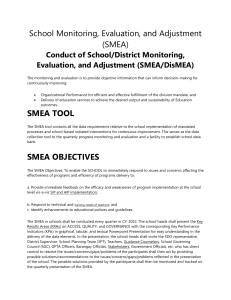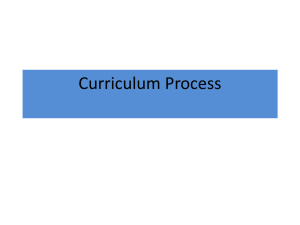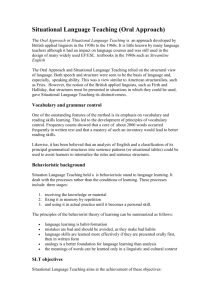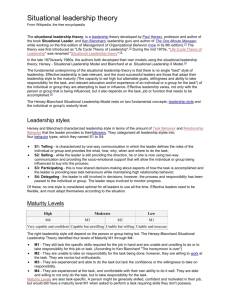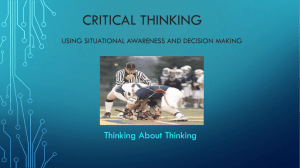Lemmen.Brinkkemper-1999-smeal_approachto
advertisement
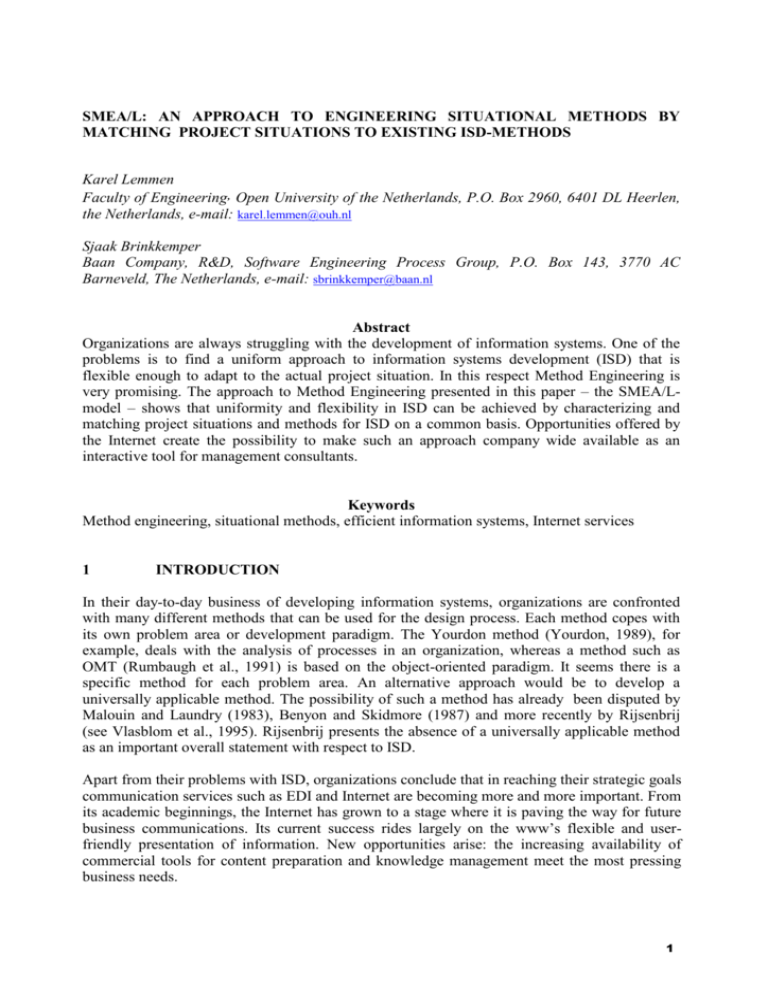
SMEA/L: AN APPROACH TO ENGINEERING SITUATIONAL METHODS BY MATCHING PROJECT SITUATIONS TO EXISTING ISD-METHODS Karel Lemmen Faculty of Engineering, Open University of the Netherlands, P.O. Box 2960, 6401 DL Heerlen, the Netherlands, e-mail: karel.lemmen@ouh.nl Sjaak Brinkkemper Baan Company, R&D, Software Engineering Process Group, P.O. Box 143, 3770 AC Barneveld, The Netherlands, e-mail: sbrinkkemper@baan.nl Abstract Organizations are always struggling with the development of information systems. One of the problems is to find a uniform approach to information systems development (ISD) that is flexible enough to adapt to the actual project situation. In this respect Method Engineering is very promising. The approach to Method Engineering presented in this paper – the SMEA/Lmodel – shows that uniformity and flexibility in ISD can be achieved by characterizing and matching project situations and methods for ISD on a common basis. Opportunities offered by the Internet create the possibility to make such an approach company wide available as an interactive tool for management consultants. Keywords Method engineering, situational methods, efficient information systems, Internet services 1 INTRODUCTION In their day-to-day business of developing information systems, organizations are confronted with many different methods that can be used for the design process. Each method copes with its own problem area or development paradigm. The Yourdon method (Yourdon, 1989), for example, deals with the analysis of processes in an organization, whereas a method such as OMT (Rumbaugh et al., 1991) is based on the object-oriented paradigm. It seems there is a specific method for each problem area. An alternative approach would be to develop a universally applicable method. The possibility of such a method has already been disputed by Malouin and Laundry (1983), Benyon and Skidmore (1987) and more recently by Rijsenbrij (see Vlasblom et al., 1995). Rijsenbrij presents the absence of a universally applicable method as an important overall statement with respect to ISD. Apart from their problems with ISD, organizations conclude that in reaching their strategic goals communication services such as EDI and Internet are becoming more and more important. From its academic beginnings, the Internet has grown to a stage where it is paving the way for future business communications. Its current success rides largely on the www’s flexible and userfriendly presentation of information. New opportunities arise: the increasing availability of commercial tools for content preparation and knowledge management meet the most pressing business needs. 1 Many companies recognise these opportunities offered by Internet not only as a customer benefit, but also as an internal communication tool. The latter opportunity is better known as Intranet. KPMG for example, an international oriented Management Consultancy firm with offices all over the world, launched Knowledge Manager (K-man) based on Internet-technology. We will discuss the Methods & Tools section of K-man that aims at providing a uniform approach to the efficient development of information systems. 1.1 Situational Method Engineering In order to have an answer to the struggle with ISD in the nineties the idea arose to construct a situational dependent ISD-approach (Kumar & Welke, 1992) by combining (parts of) existing methods. Thus we can combine the best parts of existing methods and develop an optimal solution for a given problem(area). Such (coherent) parts of methods are called method fragments. The approach of adapting and combining (parts of) different methods is also known as Situational Method Engineering (Harmsen, 1997). Van Slooten and Hodes (1996) use the term Situated Method Engineering, while Rolland and Prakash (1996) propose Context-Specific Method Engineering. The feasibility of Situational Method Engineering approaches is recently discussed in a paper by Ter Hofstede and Verhoef (1997). In this paper we present an approach to Situational Method Engineering (SME) based on a framework for ISD. Over the years several frameworks have been proposed e.g. by Olle et al. (1991), Sowa & Zachman (1992), van Swede & van Vliet (1993) and Van Slooten (1995). Such frameworks are aimed at giving an overview of the process of ISD and they are mostly based on empirical experience with that process in combination with a theoretical view on ISD. The framework we use is based on the work of Essink (1988) and will be explained in section 2. 2 SMEA/L: AN APPROACH TO SITUATIONAL METHOD ENGINEERING We already mentioned that in SME we are confronted with the question: “Which method or method fragments should be combined in order to create an optimal solution for a specific project situation?” To answer this question we should have an approach for matching a project situation to existing methods. A second question a method engineer has to answer is: “How should methods and selected fragments of method be assembled in order to get a coherent situational method?” Answering these questions leads to approaches to SME. We start with introducing the A/L-framework as a view on the process of ISD. 2.1 The A/L-framework ME frameworks give an overview of the process of IS development and are usually based upon a combination of empirical experience and theoretical views. Over the years, several frameworks mainly related to the analysis and design process in IS development have been proposed. This limited scope also holds for our A(spect)/L(evel)-framework (Figure 1) which is based on the work of Essink (1988). 2 Figure 1 The A/L-framework Each element of the A/L-framework stands for one particular aspect (A) on a specific modelling level (L) of IS development. The framework has 8 x 4 = 32 entries. We indeed observe that the A/L-framework concentrates mainly on the analysis and design aspects of IS. The strength of the framework is that it enforces the same set of aspects at each modelling level. The four modelling levels are: OSM, describes the part of the organization for which an IS should be designed and realized (the ‘why’ question); CIM, views the IS as a set of (functional) components by which the information requirements of the users should be fulfilled (the ‘what’ question); DSM, considers the IS as a data processing system (the ‘how’ question); IPM, views the IS as a concrete, operative and maintainable system (the ‘with what’ question). With respect to the eight different aspects we conclude that five of them (the shaded area in the framework) concern the architecture of the system, starting from a conceptual view (OSM, CIM) up to and including the implementation view (DSM, IPM). The remaining three aspects: goal structure, allocation and realization, should be considered in order to identify the goals, meaning and feasibility of the chosen architecture and to view the system as an operational and functional system. More details on the framework can be found in Lemmen et al. (1993). 2.2 The SMEA/L-model Using the A/L-framework, ME proceeds as illustrated in a simplified way in Figure 2. Figure 2 The SMEA/L-model (simplified view). 3 SMEA/L is an acronym for Situational Method Engineering with the A/L-framework. The A/Lframework is used in three different ways. In a generic sense the existing methods for IS development are mapped onto the framework. In a specific sense each particular project situation is to be characterized through the framework. And finally the project situation can be matched within the framework with the available methods resulting in a ‘best fit’ method or a ‘best fit’ construct or assembly of parts of different methods. Figure 3 illustrates the process of matching. Figure 3 Matching An example of characterizing a project situation and evaluating methods will be described in the next sections, including the process of matching. The SMEA/L-model has been elaborated in more detail in Punter and Lemmen (1996). Approaches to describe and fragment methods can be found in Harmsen and Brinkkemper (1995) and Harmsen (1997). An approach for characterizing project situations can also be found in Van Slooten and Hodes (1996). The above-mentioned papers also describe practical experiences with SME. The SMEA/L-model itself is also part of a research project in which the approach is used in an educational setting. In that project we validate the feasibility of SME with experienced practitioners and also use the approach for evaluating information system curricula. This can for example be found in Lemmen, Mulder and Brinkkemper (1997). 3 PROJECT CHARACTERIZATION: MAPPING A SITUATION ONTO THE FRAMEWORK The characterization of a project situation according to the presented model for Method Engineering implies the mapping of the initial problem onto the framework. Mapping means that we have to determine which of the 32 entries of the framework are related to the actual project situation. Mapping onto an entry takes place if it supports to the modelling process in order to solve the problem stated in the project. Guidelines for doing this can be found in Lemmen et al. (1993). Because of the limited space we cannot elaborate on them here. We remember the fact that each entry of the framework concerns a specific aspect of ISD on a specific modelling level. In most cases a problem is related to more than one entry in the framework. We illustrate the characterization of a project situation with the aid of the A/L-framework with an example (case study). We have the following global description of a project situation: A manufacturer of sailing boats called HOISTED SAIL employs 120 men of whom six are working with the EDP-department. HOISTED SAIL delivers sailing boats on demand. The 4 planning of the company’s production process is done by an information system called Logisplan. The system generates the list of materials needed to produce each sailing boat. It also determines the production lines on which a boat is soldered, assembled and dyed. Input data for the system includes specifications such as the size and colour of the sailing boat. The system has functioned well since its implementation eight years ago. The management however is not satisfied. Using the present system, the exact delivery date and price of a sailing boat cannot be given to clients in advance. Experience learns that such information is important for clients when deciding to buy a boat. The lack of information is a problem for the sales representatives. The management expects the sales function would be supported with more accurate data if Logisplan and the sales system were integrated. Therefore both systems should be integrated. A discussion between the members of the management team leads to the following more detailed description of the problem: There are some doubts whether the functionality of Logisplan should be further extended. After discussing this with different employees in the organization the idea arose to integrate the system with other company systems, such as the sales system and the financial systems. The boundaries of the new system are not yet specified exactly. It is not clear if several parts of the integrated system can be matched. Perhaps it will be necessary to automate activities that are not yet part of the current systems. The management of the company has also proposed to support the integrated system by communication facilities such as EDI (electronic data interchange) in order to improve the accuracy for the data of the sales representatives. We can characterize the situation by analyzing the text. Sentences in the text that describe the problem are related to entries in the A/L-framework. After explaining each sentence, a number appears. This number is used to depict the mapping of the project situation onto the framework (see figure 4). The abbreviations used in the figure are self-explaining in relation to the A/Lframework. Figure 4 The project characterization for HOISTED SAIL – The idea of integrating the system with other company systems. This implies the setting up of development goals. These goals are related to the function and quality of the integrated system. We have to determine the exact information problems. Is the lack of information for the sales representative, for example, the only information problem? These are questions on the aspect domain of goal structure (GS) on the level of conceptual information system modelling (CIM) (1). – The boundaries of the integrated system are not yet specified. 5 We must determine which of the former systems becomes part of the new integrated system. This depends on the goals of the integrated system. The boundaries of the new system and the communication between the system and its users have to be determined. This is a question related to the domain aspect environmental interaction (EI) on the level of CIM (2). – It is not clear if the several parts of the integrated system can be matched. Combining the systems for planning and sales, for example, makes it necessary to have data about stocks available. Therefore a supply function has to be incorporated. If such a subsystem is not yet available it has to be developed. A new model of entities and data collections could be developed. It depends to what degree the required functionality is covered by the existing systems. The determination of the functionality of the integrated system and the necessary data collections are subjects of the aspect functional structure (FS) and entity structure (ES) on the level of CIM (3,4). – Perhaps it is necessary to automate activities which are not yet part of the current systems. If a missing sub-system, such as the stock system, has to be developed, we need to know the organization’s relevant activities and the relationship between these activities and the environment such as clients and suppliers (functional structure (FS) and environmental interaction (EI) on the level of OSM (5,6)). – To support the integrated system with communication facilities. The subject of supporting communication facilities deals with environmental interaction on two different levels of the framework. Firstly it is related to the way in which in- and output processes are implemented, e.g. the communication could be done automatically (with EDI) or manually (by telephone). This is subject to the level of DSM (7). Secondly the technology used for communication is important. When a sales representative has questions about delivery dates or prices this could handled over the phone. When he or she places an order it has to be written down on paper. In the near future it can probably be done by EDI. This is subject to environmental interaction (EI) on the level of IPM (8). At this stage we must recognize that different messages have a different impact on the integrated system. For example a request for information starts up a process which generates data for the sales representative. An order, on the other hand, generates planning which results in the production of a boat. This forces us to pay attention to system dynamics (SD) on the level of DSM (9). This modelling area concerns about input processes. It describes the resulting database transactions that have to be triggered Figure 4 demonstrates a first characterization of the problem. It is clear that in discussions e.g. with the management of the company, it could lead to further refinements of the mapping. 4. MAPPING A METHOD ONTO THE FRAMEWORK By mapping an ISD-method onto the framework we also determine the entries in the framework that are covered by the method. Each entry can be seen as an activity during the process of system analysis and design to deliver specific products related to the new IS. In order to organize the process of mapping methods onto the framework in a more structured way, we need a template to describe methods. This template will be represented as an entity relationship diagram (figure 5). It is called the Method Entity Model. 6 Figure 5 The Method Entity Model Every method can be split up into phases. For example in Information Engineering we can distinguish the phases Strategy Planning and Business Area Analysis. Each phase in turn consists of one or more design steps that may consist of sub-steps or activities. Design steps can be anything from a technique to construct a product, such as a DFD, to a decision mark or a named but not elaborated step. However, the most important goal of a method is to deliver a product, namely (a contribution to) an information system. A product is usually delivered during those design steps that use techniques. A technique consists of a procedure that in turn is supported by specific ways of describing results (notation). For example, entity relationship modelling offers a way to present an entity relationship diagram including a procedure on how to construct such a diagram for a specific situation. Based upon the Method Entity Model, the starting point of mapping a method onto the framework is a general indication of how the method fits onto the entries in the framework. During this step we only focus on phases of the method. Investigating how the different steps in each phase are related to the entries in the framework refines the mapping. Mapping of design steps means that we try to investigate the contribution of each step to a specific entry. The same guidelines as mentioned earlier can be applied in order to map a method onto the framework (see Lemmen et al., 1993). In order to demonstrate the mapping process, we will evaluate a version of Modern Structured Analysis (MSA) by Yourdon (1989). MSA has the following structure in relation to the Method Entity Model: Phases Steps (sub-steps) Analysis Essential model Environmental model Goal description Context diagram Event list Behavioural model 7 Process model Process specifications Data dictionary Data model State (transition) diagram User Implementation model Design Implementation model System Implementation model Processor model Task model Module model Figure 6 Structure of MSA related to the Method Entity Model The essential model is related to the analysis phase. The functionality of the IS is elaborated. Therefore the essential model is almost completely mapped onto the CIM-level. The design phase on the other hand deals with the implementation model. It is mapped onto the levels DSM and IPM. The third model is the user implementation model. It is part of the analysis activity and describes the translation from the essential model to the implementation model. It appears on different levels of the A/L-framework, especially related to environmental interaction and functional structure. MSA uses several techniques, such as dataflow diagrams and event partitioning. If we study the different techniques, they can more specifically be related to the different aspect domains of the A/L-framework according to the models and phases of MSA they are part of. Figure 7 illustrates the mapping of MSA onto the framework. Figure 7 Mapping of MSA onto the A/L-framework The techniques used in the method do not necessarily support entries of the framework on which they are mapped completely. The degree of support is a further refinement of the mapping. This will not be described in this paper (see Lemmen et al., 1993). Figure 7 shows that MSA is particularly related to four aspect domains i.e. environmental interaction, functional structure, process structure and system dynamics. The mapping also shows that MSA does not take the OSM-level into consideration. 5 MATCHING THE PROJECT SITUATION TO METHOD FRAGMENTS 8 Matching the specific project situation of the HOISTED SAIL company to MSA (comparing figure 4 and figure 7) we could select fragments from MSA, for example: a description of the goals on the CIM-level, user implementation model; determines the man-machine interface and specifying operational constraints (OI on the level of DSM as well as on the level of IPM), process model; defines how a system reacts to environmental occurrences (FS on the level of CIM), data dictionary; records features of data flows and data stores (FS and ES on the level of CIM) and task model; defines the connection between processes (SD on the level of DSM). We can also conclude that MSA is not sufficient to cover the project situation as a whole. In addition, more detailed mapping will even show that MSA probably does not cover entries completely. In order to cover the project situation as a whole we have to select fragments from other methods. The missing entries of MSA with respect to the HOISTED SAIL case study are the environmental interaction and the functional structure on the level of OSM. An assessment of Information Engineering (IE) would demonstrate that fragments of IE could be mapped onto those entries. It even shows that fragments of IE cover more relevant entries of the framework in the example of the HOISTED SAIL company then MSA does, although IE doesn't cover the aspect system dynamics. The selected fragments are used as input for the assembly process. During the assembly process those fragments which fit best are selected. The assembly process consists of a set of rules that provide guidelines for assembling method fragments. This will not be elaborated in this paper. More details on the assembly process can be found in Harmsen and Brinkkemper (1994), and Punter and Lemmen (1996). Finally the assembly process results in a situational method. 6 A COMPUTERIZED TOOL BASED ON THE SMEA/L-APPROACH: A PROTOTYPE As mentioned in the introduction, a company like KPMG starts reaping the benefits of the feasibilities offered by Knowledge Manager (K-man), a company wide conferencing bulletin board and on-line communication system for management consultants. K-man fulfils needs to exchange information about a diversity of subjects. These subjects vary from Practice management (forums and information relating to managing projects) to Qualifications (for different projects broken down). Besides fulfilling the need for ordinary information exchange, K-man will contribute to the professionalization of the consultant’s main task. Within the scope of professionalization the re-use of e.g. documents and images is an important issue. K-man provides an optimal path leading to the desired destination, where the wanted object can be fetched. We would like to discuss the relation between two special subjects of K-man called Methods & Tools, and Closed Assignments which holds information about finished projects. It is aimed at enhancing the level of the consultant’s activities with two interacting mechanisms. The first mechanism contains the application of (the developed) methodology and project experiences towards current projects, while the other mechanism, which moves into the opposite direction, contains the abstraction of project experiences towards a methodology. These two mechanisms can be considered as a kind of SME: constructing a method tuned to the project situation at hand. As a concrete approach of SME we introduced the SMEA/L-approach on which the presented prototype is based. Figure 8 illustrates some screen dumps of the prototype yet 9 available. In the prototype a more comprehensive version of the SMEA/L-approach is used that is not described in the paper. Figure 8 A tool based on the SMEA/L-model One can enter the A/L–framework and subsequently zoom in on the entries in the framework. Clicking an entry shows suitable method fragments. Refinements of the tool will be based on future results of the research and should lead to a set of rules that guide a consultant in deciding what approach (read methods) should be selected in a specific situation. 7 CONCLUSION AND FURTHER RESEARCH We have outlined an approach to Situational Method Engineering in which a framework for ISD takes up a central position. We characterize both the project situation and existing ISD-methods in terms of the framework. This offers the opportunity to compare them and to select the most suitable method fragments for solving the actual problem. In order to come to a uniform but flexible approach to developing information systems, the main advantage of the presented approach to SME is that all project situations are characterized on the same basis. At the moment the proposed approach is limited by the fact that it mainly bared on the analyst’s intuition and experience to characterize a project situation, although in Lemmen et al. (1993) there are guidelines how to handle this. Future research will concentrate on structuring the process of project characterization by offering a comprehensive set of decision rules. These rules will be based on contingency models and characteristics of the 32 entries in the framework. The mapping of methods onto the framework means that we have to determine method fragments. In order to accomplish the process of method fragmentation we need to have a clear understanding of what is meant by a method fragment. Besides using the A/L-framework to characterize existing ISD-methods we also have to formulate what kind of relationships (have to) exist between different method fragments. In order to assure the overall consistency and effectiveness of a constructed situational method there should also be rules for enforcing such 10 quality (see also Harmsen & Brinkkemper, 1994). Finally this should deliver a model for fragmenting methods. It is clear that future results of the research will also lead to further extensions of the SMEA/L-tool. We conclude with the remark that models for characterizing project situations and fragmentation of methods should harmonize in order to compare them during the matching process. The topic of this paper has shown that a sound basis for such a harmonization is offered by using the same framework for characterization. ACKNOWLEDGEMENTS The authors wish to thank their colleagues for the fruitful discussions that led to many improvements of the paper, especially Frank Harmsen, Kees van Slooten, Marnix Klooster, Alfred van der Veen and Jimmy Witkam of the University of Twente, Teade Punter of Eindhoven University of Technology and Martin Boogaard of KPMG Management Consultancy. REFERENCES Benyon, D., and Skidmore, S., (1987), Towards a Tool Kit for the Systems Analyst, The Computer Journal, vol. 30, no. 1, pp. 2-7. Essink, L.J.B., (1988), A Conceptual Framework for Information Systems Development Methodologies, in: “Eurinfo '88, Proceedings of the First European Conference on Information Technology for Organizational Systems”, Bullinger, H.J. et al., eds., North Holland, Amsterdam. Harmsen, F., Brinkkemper, S. and Oei, H., (1994), Situational method engineering for information system project approaches, in: “Methods and Associated Tools for the Information Systems Life Cycle”, Verrijn-Stuart, A.A. and William Olle, T., eds., North Holland, Amsterdam. Harmsen, F., (1997), “Situational Method Engineering”, Dissertation, University of Twente, Enschede. Harmsen, F., and Brinkkemper, S., (1995), Design and Implementation of a Method Base Management System for a Situational CASE Environment, in: “Proceedings of the 2nd Asia Pacific Software Engineering Conference (APSECÆ95)”, IEEE Computer Science Press. Also in: Technical Report 95-19, Department of Computer Science, University of Twente, Enschede. Harmsen, F., and Brinkkemper, S., (1995), “Design and Implementation of a Method Base Management System for a Situational CASE Environment”, Memoranda Informatica 95-19, University of Twente, Enschede. Ter Hofstede, A.H.M., and Verhoef, T.F., (1997), On the Feasibility of Situational Method Engineering, Information Systems, vol. 22, no. 6/7, pp. 401-422. Kumar, K., and Welke, R.J., (1992), Methodology Engineering: A Proposal for SituationSpecific Methodology Construction. in: “Challenges and Strategies for Research in Systems Development”, Cotterman, W.W. and Senn, J.A., eds., Wiley. 11 Lemmen, K.A.M., Punter, H.T, Dicker, L.M.M., et al., (1993), “A methodological framework for IS-development” (textbook in Dutch), Open University of the Netherlands, Heerlen. Lemmen, K.A.M., Mulder, F., and Brinkkemper, S., (1997), Classifying information system education by method engineering, in: “Proceedings Working Conference IFIP/WG3.2”, University of Twente, Enschede. Malouin, J.L., and Landry, M., (1983), The mirage of universal methods in systems design, Journal of Applied Systems Analysis, vol. 10, pp. 47-62. Olle, T.W., J. Hagestein, MacDonald, I.G., et al., (1991), “Information Systems Methodologies - A framework for understanding”, Addison Wesley, 2nd edition, Amsterdam Punter, H., and Lemmen, K., (1996), The MEMA-model: Towards a new approach for Method Engineering, Information and Software Technology, vol. 38, no. 4, pp. 295-305. Rolland, C., and Prakash, N., (1996), A Proposal for Context-Specific Method Engineering, in: “Method Engineering: Principles of method construction and tool support”, Brinkkemper, S., Lyytinnen, K., and Welke, R.J., eds., Chapman & Hall, London. Rumbaugh, J. et al., (1991), “Object-Oriented Modeling and Design”, Prentice Hall, Englewood-Cliffs NJ. Slooten, K. van, (1995), “Situated Methods for Systems Development”, Dissertation, University of Twente, Enschede. Van Slooten, K., and Hodes, B., (1996), Characterizing IS development projects, in: “Method Engineering: Principles of method construction and tool support”, Brinkkemper, S., Lyytinnen, K., and Welke, R.J., eds., Chapman & Hall, London. Sowa, J.F., and Zachman, J.A., (1992), Extending and formalizing the framework for information systems architecture, IBM Systems Journal, vol. 31, no. 3, pp. 590-616. Swede, V. van, and van Vliet, J.C., (1993), A Flexible Framework for Contingent Information Modelling, Information and Software Technology, vol. 35, no. 9, pp. 530-548. Vlasblom, G., Rijsenbrij, D., and Glastra, M., (1995), Flexibilisation of the methodology of system development, Information and Software Technology, vol. 37, no. 11, pp. 595-607. Yourdon, E., (1989), “Modern Structured Analysis”, Prentice Hall, Englewood-Cliffs NJ. 12
